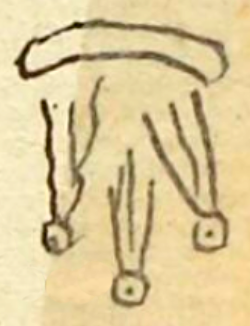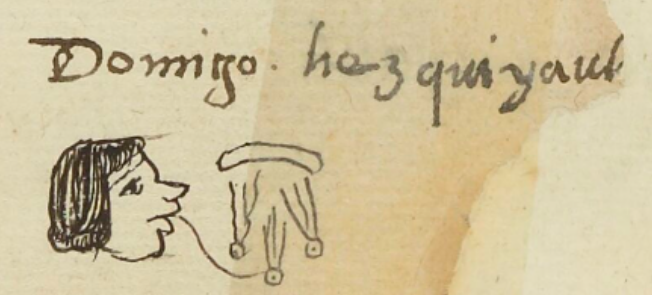Ezquiyauh (MH535r)
This black-line drawing of the compound glyph for the personal name Ezquiyauh (“It Has Rained Blood,” attested here as a man’s name) shows what may be a curved obsidian blade, possibly a semantic indicator for blood (eztli), and, below that, three streams that resemble rain (quiyahuitl).
Stephanie Wood
The curving blade might, alternatively, represent a cloud from which the raining blood falls. The iconography of rain in the second half of the sixteenth century can show the water streams coming down from clouds, as in this example from the Digital Florentine Codex. And see the example from the Codex Telleriano-Remensis, below. It may be worth noting that quiyahuitl (rain) is a day name in the 260-day divinatory calendar (the tonalpohualli).
The lines of current in the three streams suggest flow/movement. Water glyphs can sometimes be colored red to recall eztli. Cochineal dye, which is red, will sometimes look like blood (see below). Bloodletting, also shown in a pair of examples below, was a significant ritual.
Stephanie Wood
Domigo hezquiyauh
Domingo Ezquiyauh
Stephanie Wood
1560
Jeff Haskett-Wood
blood, sangre, rain, lluvia, llover

ez(tli), blood, https://nahuatl.wired-humanities.org/content/eztli
quiyahui(tl), to rain, https://nahuatl.wired-humanities.org/content/quiyahuitl
Lluvia de Sangre
Stephanie Wood
Matrícula de Huexotzinco, folio 535r, https://www.loc.gov/resource/gdcwdl.wdl_15282/?sp=149&st=image
This manuscript is hosted by the Library of Congress and the World Digital Library; used here with the Creative Commons, “Attribution-NonCommercial-ShareAlike 3.0 License” (CC-BY-NC-SAq 3.0).




